By Robert Tate, Automotive Historian and Researcher
Images courtesy of the National Automotive History Collection and Robert Tate’s collection
Posted: 04.25.2018
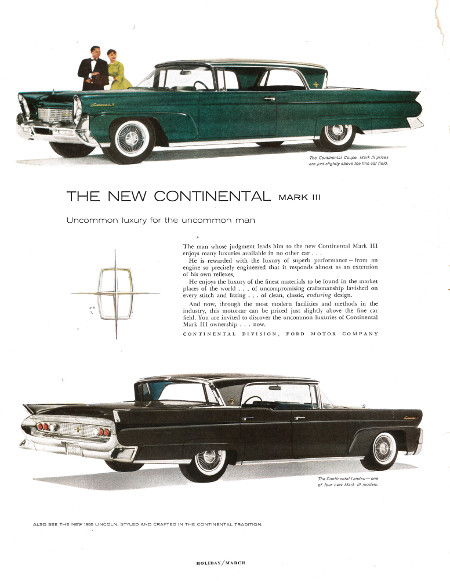 Ad for 1958 Lincoln Continental Mark III (Robert Tate Collection)The 1958 and 1959 Lincoln models by Ford were massive in size, simultaneously liked by some and disliked by others. The vehicles were so large that some suspension and chassis parts would sometimes malfunction, forcing drivers to the side of the road to call for service.
Ad for 1958 Lincoln Continental Mark III (Robert Tate Collection)The 1958 and 1959 Lincoln models by Ford were massive in size, simultaneously liked by some and disliked by others. The vehicles were so large that some suspension and chassis parts would sometimes malfunction, forcing drivers to the side of the road to call for service.
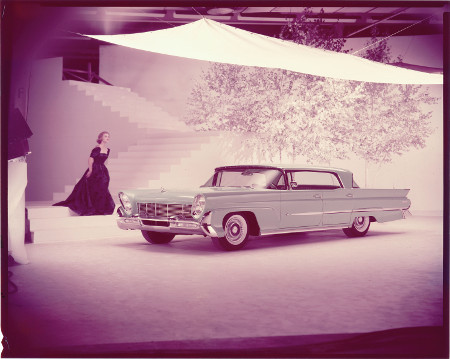 1958 Lincoln (National Automotive History Collection)The 1958 and 1959 Lincolns were designed by John Najjar, chief stylist and a great designer with Ford Motor Company from 1937 to 1979. It should also be noted that Najjar designed many other great looking vehicles during his years at Ford. Other design staff members included David Ash; Bud Kaufman; Art Miller; Herbert Todd, Lincoln’s design supervisor; and Bill Mills, Lincoln’s general manager. The models were also designed under the direction of George Walker, who was Ford Motor Company’s vice president in charge of design.
1958 Lincoln (National Automotive History Collection)The 1958 and 1959 Lincolns were designed by John Najjar, chief stylist and a great designer with Ford Motor Company from 1937 to 1979. It should also be noted that Najjar designed many other great looking vehicles during his years at Ford. Other design staff members included David Ash; Bud Kaufman; Art Miller; Herbert Todd, Lincoln’s design supervisor; and Bill Mills, Lincoln’s general manager. The models were also designed under the direction of George Walker, who was Ford Motor Company’s vice president in charge of design.
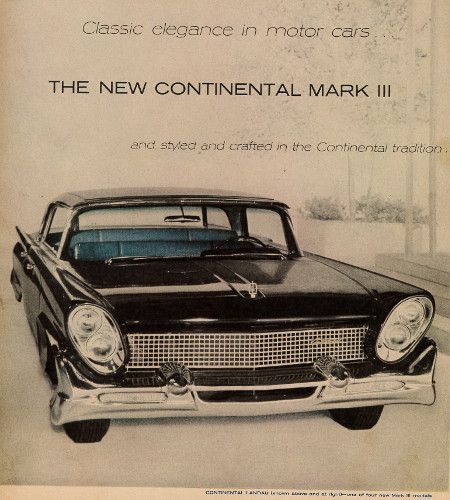 Ad for the 1958 Lincoln Continental Mark III (Robert Tate Collection)Ford called the 1958-1960 Lincolns, the massive, slab-sided Lincolns. Some 1950s automotive designs were inspired by that Buck Rogers futuristic style consumers would see at the movies. For the 1958-59 Lincolns, the design was influenced by a motorized scale model in the advance styling studio from Alex Tremulis called the La Tosca. Automotive historians over the years have said that the 1958-1960 Lincoln models were the largest unit-bodied cars and longest six-passenger vehicles ever mass-produced anywhere. However, Ford would find out that bigger was not necessarily more marketable.
Ad for the 1958 Lincoln Continental Mark III (Robert Tate Collection)Ford called the 1958-1960 Lincolns, the massive, slab-sided Lincolns. Some 1950s automotive designs were inspired by that Buck Rogers futuristic style consumers would see at the movies. For the 1958-59 Lincolns, the design was influenced by a motorized scale model in the advance styling studio from Alex Tremulis called the La Tosca. Automotive historians over the years have said that the 1958-1960 Lincoln models were the largest unit-bodied cars and longest six-passenger vehicles ever mass-produced anywhere. However, Ford would find out that bigger was not necessarily more marketable.
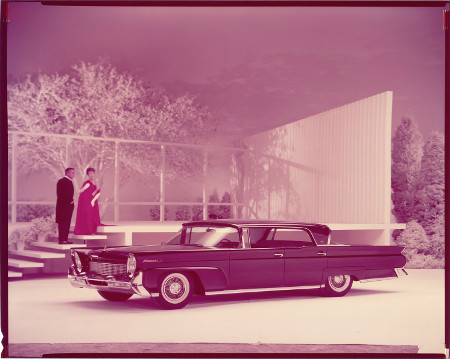 1958 Lincoln (National Automotive History CollectionLincoln advertising called the 1958 models “Classic elegance in motor cars.” For 1958, Ford’s advertising campaign placed much needed funding into the Lincoln brand, but it was not a good sales year due to an economic recession. Also, there were those who thought that the 1958 and 1959 Lincoln models were very unattractive, and the public wanted something designed much differently.
1958 Lincoln (National Automotive History CollectionLincoln advertising called the 1958 models “Classic elegance in motor cars.” For 1958, Ford’s advertising campaign placed much needed funding into the Lincoln brand, but it was not a good sales year due to an economic recession. Also, there were those who thought that the 1958 and 1959 Lincoln models were very unattractive, and the public wanted something designed much differently.
The new 1958 Lincoln models were introduced in three series, including the Capri, Premiere and the Continental Mark III. The Lincoln Capri Coupe was the lowest priced model priced at $4,803. A more expensive model was the Mark III Landau priced at $6,072. In 1959, the most expensive model was the Mark IV Limousine, which offered a retractable division window between compartments and a leather upholstered driver's compartment at a cost of $10,230.
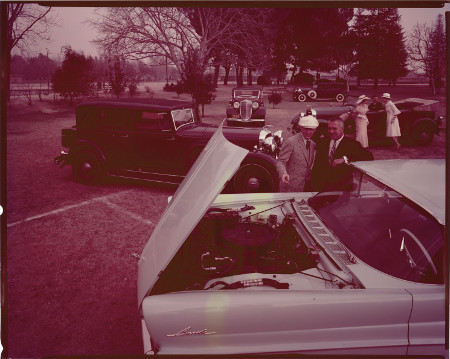 1959 Lincoln (National Automotive History Collection)Since 1958 sales were dropping, Ford thought a change was needed, so Lincoln models were given a major face-lift in 1959. Despite the models being shortened by two inches, the changes to the 1959 Lincolns did not improve sales. The 1958 and 1959 Lincoln models represented a radical departure from popular designs earlier in the 1950s.
1959 Lincoln (National Automotive History Collection)Since 1958 sales were dropping, Ford thought a change was needed, so Lincoln models were given a major face-lift in 1959. Despite the models being shortened by two inches, the changes to the 1959 Lincolns did not improve sales. The 1958 and 1959 Lincoln models represented a radical departure from popular designs earlier in the 1950s.
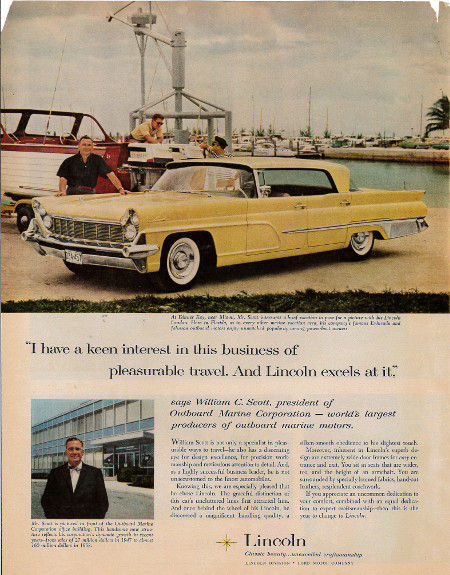 Ad for the 1959 Lincoln (Robert Tate Collection)Unfortunately, sales plummeted for the 1958 and 1959 Lincoln models. Henry Ford II said, “There is so much spendable income in the nation. We can’t afford to relax for a moment. We must offer improvements and innovations just as quickly as we can perfect them.”
Ad for the 1959 Lincoln (Robert Tate Collection)Unfortunately, sales plummeted for the 1958 and 1959 Lincoln models. Henry Ford II said, “There is so much spendable income in the nation. We can’t afford to relax for a moment. We must offer improvements and innovations just as quickly as we can perfect them.”
Bibliography
The Auto Editors of Consumer Guide with Jeffrey Godshall. “Designing America’s Cars the 50s”
Damman, H. George. “50 Years of Lincoln-Mercury.” Crestline Publishing, 1971.


